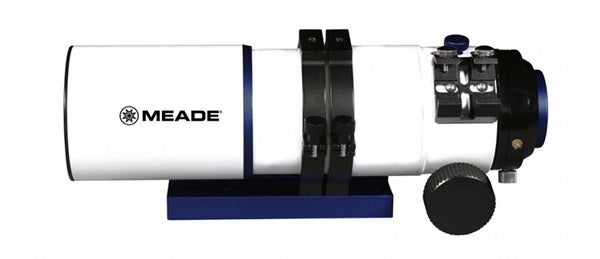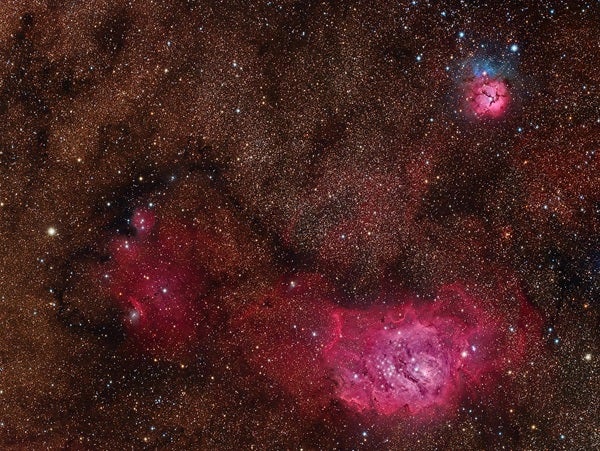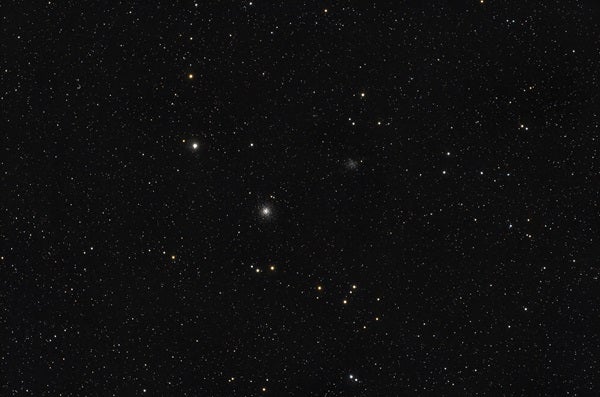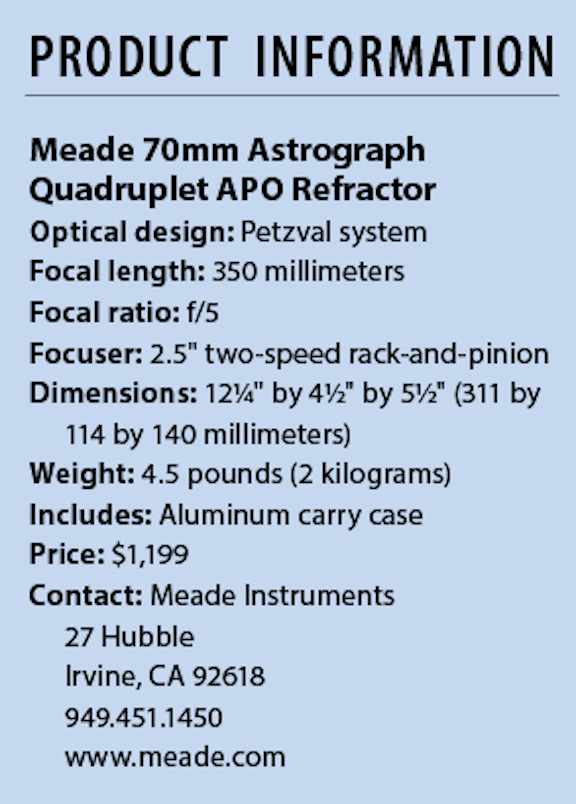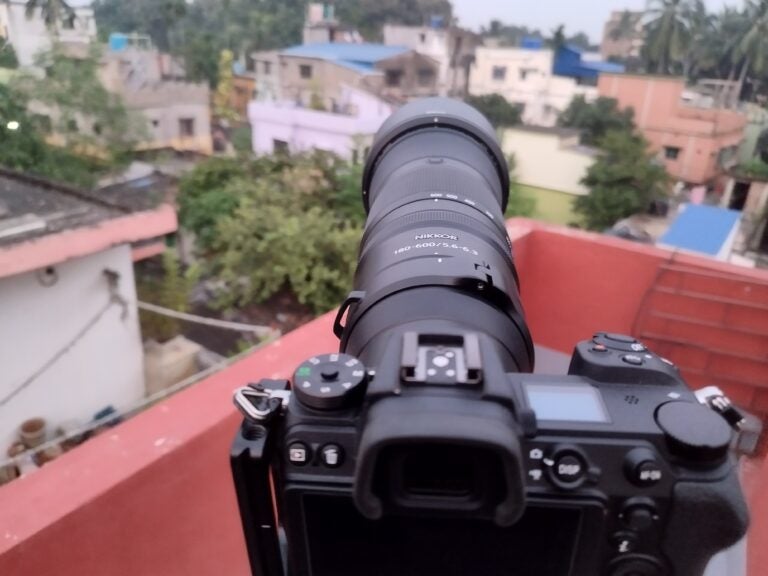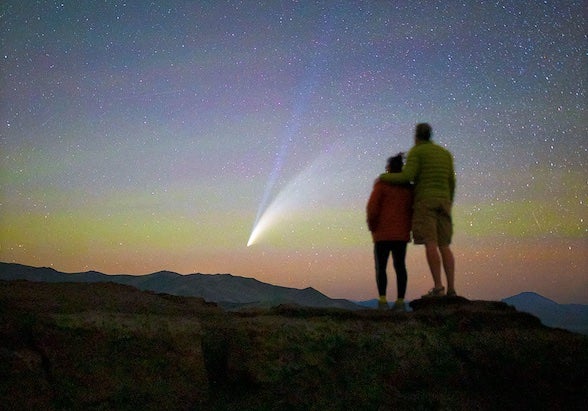When I take wide-field shots, I enjoy the simplicity of unguided imaging that short-focal-length instruments allow. So, I jumped at the opportunity to put this scope through its paces in my backyard observatory.
The scope arrived in a nice aluminum carrying case packed in cutout foam. It included attached rings with a short, blue-anodized Vixen-style dovetail plate bolted to them. Also mounted to the tube was an adapter for a red-dot finder or other pointing device.
The scope is quite light, weighing in at just 4.5 pounds (2 kilograms). It has a white finish and comes with a sliding dew shield with a light-blue-anodized push-on lens cover. The 2.5″ focuser features a standard coarse-focus knob on one side and a 10-to-1 blue-anodized fine-focus knob on the other. The range of the focuser is 30 mm with an engraved scale on top. Racking it in and out felt buttery smooth.
The back end of the drawtube includes a screw-on cover and terminates with a 48-mm rotatable threaded opening, which is also smooth. Meade doesn’t include a star diagonal because the scope is an astrograph and not a visual instrument.
Optically, the 70mm Astrograph is a Petzval design with a doublet lens up front and two more corrective elements farther back within the tube assembly. Each of the four elements is made from extra-low-dispersion glass, and all are fully multicoated.
Mounting
When I tried to mount the scope on my Paramount MyT, I noticed a problem. I wanted to use a Losmandy-style dovetail plate and slide it onto my mount’s plate. However, that wasn’t possible because of the low-profile rings. There was barely any room between the bottom of the scope and dovetail plate, so it was impossible to attach a camera. The camera would hit the dovetail plate, and there was no way to move the scope forward to balance.
The only solution would be to attach a set of risers to the rings. These would raise the scope enough to allow me to attach a camera. I didn’t have any risers that would fit the rings, so I mounted a different scope on the MyT and bolted the Meade to a short dovetail plate that rode on top of the other scope’s rings. This provided me with enough room to attach the camera to the scope and still slide it forward or backward to balance the setup.
The critical focus zone of an f/5 telescope like this one is tiny, on the order of 22 micrometers through a green filter, so I also wanted to hook up a motorized focuser to achieve best focus using automation. Luckily I had one designed for 2.5″ and 3″ focusers. I easily adapted it to the Meade focuser, mounting it on the fine-focuser knob’s side. I used a few shims to allow the unit to tighten around the planetary gear housing, and it fit nicely.
With the scope mounted, the first camera I decided to use was the SBIG STL-11000. I wanted to see how the scope handled a full-frame chip and to see if the focuser would handle the weight of this large camera. This camera’s detector is a standard 36×24 mm chip with 9-micrometer pixels. It provided an image scale of 5.35″ per pixel, which yielded a huge field of view of 6° by 4°.
This setup can take in sweeping views of large objects. The scope’s advertised image circle is 42 mm, and the full-frame camera worked well with it. Once in focus, I used CCD Inspector to measure the collimation and curvature.
Collimation was spot on (within 1 pixel). Curvature measured 10 to 11 percent, a quite respectable number. My flat-field analysis shows light loss to be 8 to 9 percent in one corner and less in others. This means vignetting is minimal and probably due to a bit of tilt in the system with the large chip.
When I zoomed in to a full-size image, I noticed that the stars in the extreme corners of the chip were not perfectly round but slightly elongated. It wasn’t objectionable, however. Being right at the edge of the image circle, the optics did a decent job of providing good correction out to the edge of the field.
Also, as far as I could tell, the focuser did a good job holding this nearly 5-pound camera without sagging. With an adapter and a spacer on the camera, it threaded right onto the rear of the focuser. The camera-scope combination came to focus about 15 mm out from the fully racked-in point. The camera was easy to rotate to any desired angle. Because the focuser held this large camera well, it will have no issue holding other CCD cameras and DSLRs.
I also tested the scope with my QSI 583 camera, which uses an APS-C Kodak 8300 chip with a diameter of 22.5 mm and 5.4-micrometer pixels. This camera resulted in a image scale of 3.21″ per pixel and a large field of view of 3° by 2°. With just the adapter threaded into the camera, this setup came to focus about 9 mm out. The first test images showed excellent correction all the way into the corners.
Curvature measured again around 10 to 11 percent, and a flat-field analysis showed light loss in the corners to be only around 4 percent. I saw no vignetting. With either camera, the focal length measured out at 349 mm, which is right on the money with the advertised 350 mm focal length.
From these initial tests, I concluded that excellent images are possible with either a full-frame or APS-C camera.
After waiting a week for the weather to improve (including a near miss by a tropical storm), I finally got some clear nights to put the scope through its paces. With the SBIG camera, I targeted the globular cluster M53 and its companion NGC 5053. With the QSI camera, I imaged the globular cluster M5 and later at night the region of the Lagoon and Trifid nebulae (M8 and M20) in Sagittarius.
The extremely wide field afforded by the latter instrument allowed me to cover a huge portion of the sky. This scope’s fast (f/5) focal ratio made acquiring the data quick. After processing the images, I was happy to see that there were no optical issues whatsoever.
Final thoughts
The 70mm Astrograph Quadruplet APO Refractor is an excellent scope for imaging. The optics are tack-sharp, and I didn’t notice any chromatic aberration, telling me that the lens elements are matched well. The scope produces little vignetting using 48 mm adapters. Its ability to bring all the colors to focus at nearly the same point was excellent.
Meade’s focuser is also well made and smooth. I had no issues with sagging, even when I used a heavy camera. It comes with a manual rotator, which makes it easy to set your camera to any angle. The focuser also can accept focus motors from several different suppliers.
The rings supplied with the scope could use some help. You’ll need risers to be able to set up the scope with a camera on a Losmandy-style dovetail plate. If you use it on a mount with a Vixen-style plate, you may be able to use your camera without risers. In either case, risers will definitely come in handy. When I tightened the rings, the two halves bottomed out, so I wasn’t sure if the scope was secure within them. Using a bit of tape as a shim will help tighten the ring connection.
All in all, Meade’s Astrograph is an extremely capable and well-corrected telescope that should let you capture some spectacular wide-field images.

